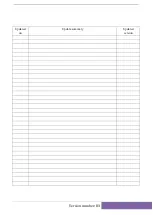
18
SECTION 5: TORQUE VERSUS SPEED
CHARACTERISTICS
5.1 MOTOR PERFORMANCE
All stepper motors exhibit instability at their natural frequency and
harmonics of that frequency. Typically, this instability occurs at speeds
between 50 and 1000 full steps per second and, depending on the
dynamic motor load parameters, cause excessive velocity modulation or
improper positioning. This type of instability is represented by the open
area at the low end of each Torque vs. Speed curve.
There are also other instabilities which may cause a loss of torque at
stepping rates outside the range of natural resonance frequencies. One
such instability is broadly defined as mid-range instability. Usually, the
damping of the system and acceleration/deceleration through the
resonance areas aid in reducing instability to a level that provides smooth
shaft velocity and accurate positioning. If instability does cause
unacceptable performance under actual operating conditions, the
following techniques can be used to reduce velocity modulation.
1)
Avoid constant speed operation at the motor's unstable
frequencies. Select a base speed that is above the motor's resonant
frequencies and adjust acceleration and deceleration to move the
motor through unstable regions quickly.
2)
The motor winding current can be reduced as described in Section
4.5. Lowering the current will reduce torque proportionally. The
reduced energy delivered to the motor can decrease velocity
modulation.
3)
Using another step resolution may provide smoother operation
and reduce the effects of mid range instability.
Microstepping
changes the shaft speed for a given pulse input rate
.
Содержание Superior SLO-SYN SS2000MD4-M
Страница 21: ...20 1 10 MICROSTEP M062LE09 ETC MOTORS SERIES CONNECTED 1 10 MICROSTEP M062LE09 ETC MOTORS PARALLEL CONNECTED...
Страница 22: ...21 1 10 MICROSTEP M063LE09 ETC MOTORS SERIES CONNECTED 1 10 MICROSTEP M063LE09 ETC MOTORS PARALLEL CONNECTED...
Страница 25: ...24...
Страница 26: ...25...
Страница 27: ...26...
Страница 28: ...27...













































